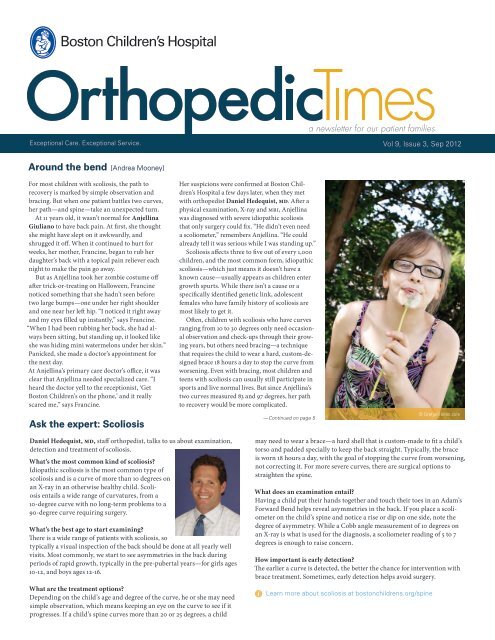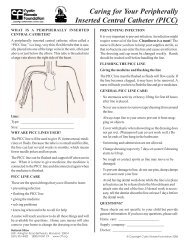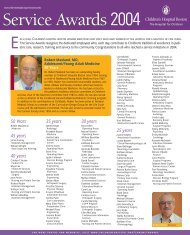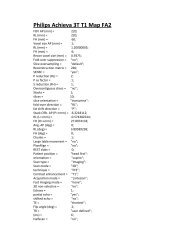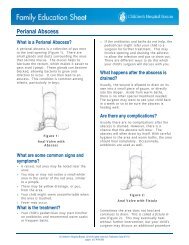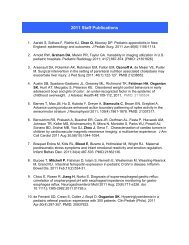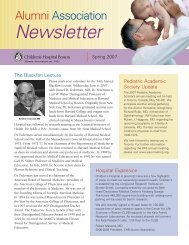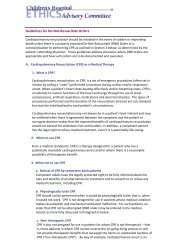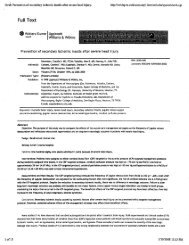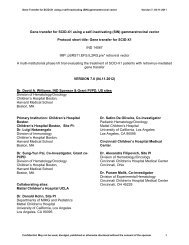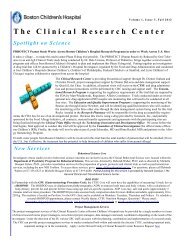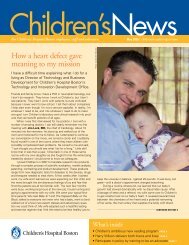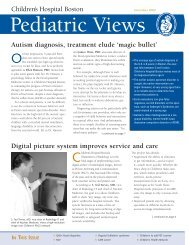Ortho Times Vol 24 - Children's Hospital Boston
Ortho Times Vol 24 - Children's Hospital Boston
Ortho Times Vol 24 - Children's Hospital Boston
Create successful ePaper yourself
Turn your PDF publications into a flip-book with our unique Google optimized e-Paper software.
a newsletter for our patient families<br />
Exceptional Care. Exceptional Service. <strong>Vol</strong> 9, Issue 3, Sep 2012<br />
Around the bend [Andrea Mooney]<br />
For most children with scoliosis, the path to<br />
recovery is marked by simple observation and<br />
bracing. But when one patient battles two curves,<br />
her path—and spine—take an unexpected turn.<br />
At 11 years old, it wasn’t normal for Anjellina<br />
Giuliano to have back pain. At first, she thought<br />
she might have slept on it awkwardly, and<br />
shrugged it off. When it continued to hurt for<br />
weeks, her mother, Francine, began to rub her<br />
daughter’s back with a topical pain reliever each<br />
night to make the pain go away.<br />
But as Anjellina took her zombie costume off<br />
after trick-or-treating on Halloween, Francine<br />
noticed something that she hadn’t seen before:<br />
two large bumps—one under her right shoulder<br />
and one near her left hip. “I noticed it right away<br />
and my eyes filled up instantly,” says Francine.<br />
“When I had been rubbing her back, she had always<br />
been sitting, but standing up, it looked like<br />
she was hiding mini watermelons under her skin.”<br />
Panicked, she made a doctor’s appointment for<br />
the next day.<br />
At Anjellina’s primary care doctor’s office, it was<br />
clear that Anjellina needed specialized care. “I<br />
heard the doctor yell to the receptionist, ‘Get<br />
<strong>Boston</strong> Children’s on the phone,’ and it really<br />
scared me,” says Francine.<br />
Ask the expert: Scoliosis<br />
Daniel Hedequist, MD, staff orthopedist, talks to us about examination,<br />
detection and treatment of scoliosis.<br />
What’s the most common kind of scoliosis?<br />
Idiopathic scoliosis is the most common type of<br />
scoliosis and is a curve of more than 10 degrees on<br />
an X-ray in an otherwise healthy child. Scoliosis<br />
entails a wide range of curvatures, from a<br />
10-degree curve with no long-term problems to a<br />
90-degree curve requiring surgery.<br />
What’s the best age to start examining?<br />
There is a wide range of patients with scoliosis, so<br />
typically a visual inspection of the back should be done at all yearly well<br />
visits. Most commonly, we start to see asymmetries in the back during<br />
periods of rapid growth, typically in the pre-pubertal years—for girls ages<br />
10-12, and boys ages 12-16.<br />
What are the treatment options?<br />
Depending on the child’s age and degree of the curve, he or she may need<br />
simple observation, which means keeping an eye on the curve to see if it<br />
progresses. If a child’s spine curves more than 20 or 25 degrees, a child<br />
Her suspicions were confirmed at <strong>Boston</strong> Children’s<br />
<strong>Hospital</strong> a few days later, when they met<br />
with orthopedist Daniel Hedequist, MD. After a<br />
physical examination, X-ray and MRI, Anjellina<br />
was diagnosed with severe idiopathic scoliosis<br />
that only surgery could fix. “He didn’t even need<br />
a scoliometer,” remembers Anjellina. “He could<br />
already tell it was serious while I was standing up.”<br />
Scoliosis affects three to five out of every 1,000<br />
children, and the most common form, idiopathic<br />
scoliosis—which just means it doesn’t have a<br />
known cause—usually appears as children enter<br />
growth spurts. While there isn’t a cause or a<br />
specifically identified genetic link, adolescent<br />
females who have family history of scoliosis are<br />
most likely to get it.<br />
Often, children with scoliosis who have curves<br />
ranging from 10 to 30 degrees only need occasional<br />
observation and check-ups through their growing<br />
years, but others need bracing—a technique<br />
that requires the child to wear a hard, custom-designed<br />
brace 18 hours a day to stop the curve from<br />
worsening. Even with bracing, most children and<br />
teens with scoliosis can usually still participate in<br />
sports and live normal lives. But since Anjellina’s<br />
two curves measured 83 and 97 degrees, her path<br />
to recovery would be more complicated.<br />
—Continued on page 5<br />
© GretjenHelen.com<br />
may need to wear a brace—a hard shell that is custom-made to fit a child’s<br />
torso and padded specially to keep the back straight. Typically, the brace<br />
is worn 18 hours a day, with the goal of stopping the curve from worsening,<br />
not correcting it. For more severe curves, there are surgical options to<br />
straighten the spine.<br />
What does an examination entail?<br />
Having a child put their hands together and touch their toes in an Adam’s<br />
Forward Bend helps reveal asymmetries in the back. If you place a scoliometer<br />
on the child’s spine and notice a rise or dip on one side, note the<br />
degree of asymmetry. While a Cobb angle measurement of 10 degrees on<br />
an X-ray is what is used for the diagnosis, a scoliometer reading of 5 to 7<br />
degrees is enough to raise concern.<br />
How important is early detection?<br />
The earlier a curve is detected, the better the chance for intervention with<br />
brace treatment. Sometimes, early detection helps avoid surgery.<br />
Learn more about scoliosis at bostonchildrens.org/spine
Welcome Aboard [Krystal Spencer]<br />
The <strong>Ortho</strong>pedic Center at <strong>Boston</strong> Children’s <strong>Hospital</strong> is pleased to announce the following additions to our medical team.<br />
Bryce Gillespie, MD<br />
Dr. Gillespie received his medical degree, with<br />
distinction in research, from the University of<br />
Rochester School of Medicine and Dentistry<br />
in Rochester, NY. He completed a residency in<br />
orthopedic surgery at the Harvard Combined<br />
<strong>Ortho</strong>paedic Residency Program, where he<br />
rotated though the Massachusetts General<br />
<strong>Hospital</strong>, Brigham & Women’s <strong>Hospital</strong>, Beth<br />
Israel Deaconess Medical Center, the Veterans<br />
Affairs Healthcare System, and <strong>Boston</strong> Children’s<br />
<strong>Hospital</strong>. Dr. Gillespie completed the<br />
Harvard Hand and Upper Extremity Surgery<br />
Fellowship at Brigham & Women’s <strong>Hospital</strong> and <strong>Boston</strong> Children’s <strong>Hospital</strong>.<br />
Dr. Gillespie is joining us as an instructor in orthopedic surgery at Harvard<br />
Medical School, and a staff surgeon at <strong>Boston</strong> Children’s. Dr. Gillespie<br />
will be seeing hand and upper extremity patients at our <strong>Boston</strong>, Peabody,<br />
Waltham, and Weymouth locations. This includes patients of all ages with<br />
congenital differences, sports-related injuries, traumatic injuries, and other<br />
conditions affecting the shoulder, arm, elbow, forearm, wrist and hand.<br />
Michael Beasley, MD<br />
Dr. Beasley received his medical degree<br />
from the University of Iowa Carver College<br />
of Medicine in Iowa City, IA. He completed<br />
an internship and residency in pediatrics at<br />
Phoenix Children’s <strong>Hospital</strong>/Maricopa Medical<br />
Center, in Arizona. Dr. Beasley completed<br />
a primary care sports medicine fellowship<br />
at <strong>Boston</strong> Children’s <strong>Hospital</strong> and Harvard<br />
Medical School.<br />
Dr. Beasley is joining us as a staff physician<br />
in the Division of Sports Medicine. He will be<br />
seeing patients with sports medicine injuries, with a focus on concussions,<br />
at our <strong>Boston</strong>, Peabody and Waltham locations.<br />
Sports related concussions<br />
[Alexandra Wade & William Meehan, MD]<br />
The new school year and fall sports season is fast approaching. Before the<br />
sports season begins it is important for parents and children to be aware of the<br />
risks associated with contact sports, particularly sport-related concussions.<br />
Sport-related concussion is an increasingly common diagnosis in<br />
young athletes. Many athletes don’t recognize concussions because they<br />
do not know the signs and symptoms of this injury. By learning more<br />
about what a concussion is parents and children will be able to recognize<br />
it and seek treatment.<br />
A concussion is a type of traumatic brain injury caused by a sudden,<br />
rotational acceleration of the brain. Because the rotational acceleration is<br />
not a natural movement of the brain, it causes a temporary disruption in<br />
normal brain function.<br />
Common symptoms of a concussion include but are not limited to<br />
headaches, dizziness, nausea, vomiting, difficulty concentrating, difficulty<br />
with balance, sensitivity to light and sensitivity to noise. In addition to the<br />
athlete experiencing symptoms, people surrounding the athlete may notice<br />
signs or changes in their behavior.<br />
Signs of a concussion vary greatly but may include loss of consciousness,<br />
forgetfulness, depression, disorientation, poor physical coordination, and<br />
changes in personality. These signs and symptoms may also be associated<br />
with other medical ailments. This is why it is important to see a medical<br />
Chandlee Gore Holland, NP, RN<br />
Prior to joining us, Chandlee was an information<br />
systems analyst at Beverly <strong>Hospital</strong> in<br />
Beverly MA. She has also held positions as a<br />
registered nurse, and pediatric nurse practitioner<br />
at Kaiser Permanente in San Francisco.<br />
Chandlee received a bachelor of arts in<br />
Spanish from Whitman College in Washington.<br />
She then went on to receive a masters of<br />
science in nursing from the Massachusetts<br />
General <strong>Hospital</strong>’s Institute of Health Professions,<br />
here in <strong>Boston</strong>.<br />
Kathleen Massey, RN, BSN<br />
Kathleen comes to us from the fast paced,<br />
emergency department here at <strong>Boston</strong><br />
Children’s. Kathleen has held previous<br />
clinical positions at Spaulding Rehabilitation<br />
<strong>Hospital</strong>, and Yale New Haven <strong>Hospital</strong>. She<br />
completed her student internship at Brigham<br />
and Women’s <strong>Hospital</strong>.<br />
After completing a bachelor of science<br />
degree in nursing from Fairfield University<br />
in Connecticut, Kathleen went on to obtain<br />
a masters degree in nursing from <strong>Boston</strong> College. She also is certified in<br />
Pediatric Advanced Life Support (PALS) as well as BasicLife Support (BLS).<br />
Fact or Fiction?<br />
Girls are more likely to tear their ACLs.<br />
Fact! Girls are five to eight times more likely to tear their anterior<br />
cruciate ligament (ACL) than boys who play the same sports,<br />
and 25 percent of girls will re-tear their ACLs. Fortunately, girls<br />
can reduce their risk with a proper prevention program, which<br />
focuses on increasing lower body strength, balance and agility.<br />
—Martha Murray, MD<br />
<strong>Ortho</strong>pedic surgeon, <strong>Boston</strong> Children’s <strong>Hospital</strong><br />
professional who obtains sufficient medical history to ensure the signs and<br />
symptoms are in fact a result of a concussion. In addition, medical professionals<br />
can make sure the athlete is not suffering from another injury.<br />
While concussion is the most common neurological injury in sports, it<br />
is not the only one. Once it’s been determined that an athlete has sustained<br />
a concussion and is not suffering from a different neurological injury, it is<br />
important to remove the athlete from play. Concussed athletes should be<br />
prescribed physical and cognitive rest. If symptoms worsen, they should<br />
seek emergency medical attention immediately. Athletes who respond well<br />
to physical and cognitive rest should schedule an appointment with a physician<br />
trained in assessing and treating concussions, usually their primary<br />
care physician. The doctor will decide if academic accommodations need<br />
to be put in place and help determine when the athlete can return to play.<br />
Sport related concussions must be taken seriously by parents and<br />
athletes. Most concussions can heal quickly if managed appropriately. If<br />
you believe your child has sustained a concussion during an athletic event<br />
and you would like them to be evaluated by one of our Sports Medicine<br />
physicians please call 781-216-1328 to make an appointment.<br />
Learn more about sports related concussions at<br />
bostonchildrens.org/sportsmed
Periacetabular osteotomy, easier than pulling teeth [Sam Keif]<br />
In the fall of 2011, 18 year-old New York City<br />
native Jared Cohen noticed some slight pain in<br />
his right groin, and initially thought it was something<br />
as simple as a small muscle pull or strain.<br />
Jared continued to play competitive tennis<br />
and recreational sports until the pain became<br />
too severe to ignore. “Once I realized that the<br />
pain was progressively getting worse over time<br />
and that extra stretching was doing very little<br />
to fix what I thought was a simple groin pull, I<br />
decided to get it checked out” says Jared. Jared<br />
saw an orthopedic specialist in New York City<br />
who diagnosed Jared with a labral tear and hip<br />
dysplasia. The specialist suggested that Jared<br />
get a complex hip surgery called a periacetabular<br />
osteotomy (PAO). “I thought that I was<br />
way too young for this. I had heard about my<br />
parents’ friends or my grandparents’ friends<br />
having hip problems, but I’m 18 years old, had<br />
been perfectly healthy for my entire life and<br />
was a little bit shocked at the time.”<br />
Jared and his family were encouraged by<br />
family friends and various physicians to seek<br />
treatment at <strong>Boston</strong>’s Children’s <strong>Hospital</strong> who<br />
have a world renowned hip program, led by<br />
Young-Jo Kim, MD, PhD.<br />
Erin Dawicki, physician assistant for the<br />
Child and Adult Preservation Program, explains<br />
the process of a PAO “A PAO is a surgery<br />
done on patients whose hip socket is too<br />
shallow. The hip is a ball and socket joint. The<br />
bone around the socket is cut so that the socket<br />
can be rotated into a better position over the<br />
ball. This makes the hip healthier and hopefully<br />
stops the hip from getting arthritis.”<br />
Jared first came to <strong>Boston</strong>’s Children’s in<br />
early May to meet with Dr. Kim for a clinical<br />
evaluation and discuss the option of a PAO<br />
surgery. “I knew a PAO was my best option<br />
because of how clearly and thoroughly Dr. Kim<br />
described my choices, but realized that my<br />
entire summer would be spent on crutches and<br />
possibly my first few weeks of college if I went<br />
through with it.<br />
As for the procedure itself, I had never had any<br />
type of surgery before, so the idea of my first<br />
one involving the sawing of my hip didn’t sit<br />
too well with me at first. But, Dr. Kim’s explanations<br />
and the information in the PAO packet I<br />
was given helped make me more comfortable.”<br />
In June of this year, Jared came to <strong>Boston</strong><br />
Children’s to have PAO surgery performed on<br />
his right hip “My overall surgical experience<br />
exceeded my expectations in every way. The<br />
nurses, anesthesiologists and doctors I talked<br />
to the morning of the surgery, including Dr.<br />
Kim obviously, were very nice and answered<br />
any questions I had.” After Jared’s successful<br />
surgery he spent six days at <strong>Boston</strong> Children’s.<br />
“All of the nurses and doctors who stopped<br />
by my room were great, as were the hospital’s<br />
physical therapists I worked with a few days<br />
after the surgery.” Overall, Jared was surprised<br />
on how easy and smooth the overall surgical<br />
process was. “I am supposed to get my wisdom<br />
teeth pulled in the coming weeks. I’m dreading<br />
that more so than I would getting another PAO<br />
at <strong>Boston</strong> Children’s.”<br />
Jared’s outlook is outstanding and he is<br />
excited and thrilled to be starting college at<br />
Yale University in New Haven, Connecticut in<br />
the fall.<br />
Image courtesy of Jared Cohen<br />
Learn more about hip dysplasia at<br />
bostonchildrens.org/hip<br />
Your thoughts and opinions inspire<br />
us to make changes to better your<br />
experience here. Please take a moment<br />
to visit our website and fill out<br />
our patient satisfaction survey.<br />
bostonchildrens.org/ortho<br />
NEW CAST?<br />
At <strong>Boston</strong> Children’s we have an excel-<br />
lent group of orthopedic technicians that<br />
will apply or remove your child’s cast.<br />
Whether or not this is your child’s first<br />
cast or tenth, you may have some questions<br />
about how to care for a cast, or<br />
what to expect during the application<br />
or removal process.<br />
We understand that not all concerns<br />
come to mind while you are in the presence<br />
of our orthopedic team. We have<br />
provided information on our website<br />
that can help answer these questions,<br />
as well as additional information to<br />
help you through your child’s healing<br />
process.<br />
At <strong>Boston</strong> Children’s, we are committed<br />
to providing our patient families with<br />
all the necessary information to help<br />
the children we treat have the best<br />
healing experience possible. Whether<br />
your child has a minor injury or a<br />
complex condition we want you and<br />
your child to feel that you are the most<br />
important people we are taking care of.<br />
We will not rest until every child is well.<br />
Learn more about caring for your cast<br />
at bostonchildrens.org/ortho/cast
<strong>Boston</strong> Children’s <strong>Hospital</strong> Ranks #1 on U.S. News & World Report<br />
Best Children’s <strong>Hospital</strong>s Honor Roll<br />
Ranked in the Top 4 in all 10 Specialty Areas<br />
<strong>Boston</strong> Children’s <strong>Hospital</strong> ranks first in the<br />
U.S. News and World Report’s 2012-13 Best<br />
Children’s <strong>Hospital</strong>s Rankings Honor Roll.<br />
<strong>Boston</strong> Children’s is first in Cardiology &<br />
Heart Surgery, Nephrology, Neurology &<br />
Neurosurgery; second in Cancer, Diabetes &<br />
Endocrinology, Gastroenterology and Urology;<br />
third in Neonatology and <strong>Ortho</strong>pedics; and<br />
fourth in Pulmonology. <strong>Boston</strong> Children’s<br />
partners with Dana-Farber Cancer Institute to<br />
operate the Dana-Farber/Children’s <strong>Hospital</strong><br />
Cancer Center – an integrated pediatric oncology<br />
program.<br />
“We’re honored by this recognition and view<br />
it as a challenge to continue to work tirelessly<br />
to improve the quality of care given to each<br />
and every family that comes through our<br />
doors,” says James Mandell, MD, CEO of <strong>Boston</strong><br />
Children’s <strong>Hospital</strong>.<br />
The rankings feature 50 hospitals in each<br />
of 10 pediatric specialties: cancer, cardiology<br />
How clinical research directly impacts patient care<br />
[Adam Nasreddine and Anni Lierhaus]<br />
For nearly a decade, one option for treating femur (thigh bone) fractures in children and adolescents<br />
with surgery has included the use of a metal plate secured across the broken bone to hold the two<br />
ends in place while healing takes place. Research studies from this and other institutions showed<br />
that plate fixation was safe and resulted in similar or better outcomes than other treatment techniques<br />
available for some types of fractures. While practice patterns varied somewhat, the consensus<br />
among most orthopedic surgeons was that it was not necessary to remove the plate after successful<br />
fracture healing, unless it was causing the patient problems.<br />
Recently, physicians in the <strong>Ortho</strong>pedic Center<br />
noticed that a couple of patients returned to<br />
clinic many months after their fracture had<br />
healed, complaining of knee pain. X-rays<br />
revealed that the patients were developing<br />
a valgus deformity, in which the thigh bone<br />
becomes bowed. This observation caused physicians<br />
to wonder if the deformity was occurring<br />
in other patients but going undetected.<br />
With the approval of <strong>Boston</strong> Children’s <strong>Hospital</strong>’s<br />
Institutional Review Board, researchers<br />
in the <strong>Ortho</strong>pedic Center reviewed the medical<br />
records for all patients whose femur fractures<br />
were treated, over the last five years, with a<br />
plate. They discovered that progression of a<br />
valgus deformity could be detected in approximately<br />
10% of patients.<br />
For most of these patients, the deformity<br />
progression was minimal and didn’t cause any<br />
other symptoms. This was reassuring. However,<br />
for two patients (these were the patients<br />
that inspired this study,) the bowing of the leg<br />
had become so severe that surgical correction<br />
was required.<br />
and heart surgery, diabetes and endocrinology,<br />
gastroenterology, neonatology, nephrology,<br />
neurology and neurosurgery, orthopedics, pulmonology,<br />
and urology. Eighty hospitals across<br />
the country ranked in one or more specialties.<br />
<strong>Boston</strong> Children’s was the only hospital in New<br />
England named to the U.S. News Honor Roll,<br />
and was ranked in the top 25<br />
“The rankings reflect the dedication of our<br />
caregivers, researchers, staff, volunteers and<br />
referring doctors across <strong>Boston</strong> Children’s<br />
community of care,” adds Sandra Fenwick,<br />
President and COO of <strong>Boston</strong> Children’s. “Our<br />
staff represents the finest in their fields, and<br />
it’s only through working together that we can<br />
provide such exceptional care.”<br />
This year, U.S. News surveyed 178 pediatric<br />
centers to obtain hard data such as availability<br />
of key resources and ability to prevent complications<br />
and infections. The hospital survey<br />
made up 75 percent of the evaluation to determine<br />
rankings. A separate reputational survey<br />
Results of this investigation were presented at<br />
a physician staff meeting and it was decided<br />
that patients who were believed to be at high<br />
risk of developing a valgus deformity should be<br />
contacted and asked to return for clinical and<br />
X-ray evaluation of their fractured leg. Patients<br />
considered to be at high risk were those whose<br />
plate was placed close to the knee joint and<br />
who were very young immature at the time<br />
of the fracture. Several patients returned for<br />
follow-up and were found not to have any problems.<br />
One patient, who initially didn’t respond<br />
to phone calls from the research team, later<br />
presented to the clinic a couple of months later<br />
with knee pain and a valgus deformity severe<br />
enough that surgical treatment was necessary.<br />
Based on the results of this study, physicians<br />
now believe it is important to follow patients<br />
and continue to take X-rays as necessary,<br />
not just until the fracture is healed, but until<br />
the patient reaches skeletal maturity. This<br />
study is a good example of how our clinical research<br />
can improve our knowledge and result<br />
in better patient care and outcomes.<br />
in which 1,500 pediatric specialists—150 in<br />
each specialty—were asked where they would<br />
send the sickest children in their specialty<br />
made up the remaining 25 percent of data used<br />
for evaluation.<br />
This patient’s fracture was healed at 6<br />
months. The patient returned 3 years later<br />
because of pain, and was found to have<br />
a major valgus deformity (the left leg is<br />
bowed in and closer to the right leg).<br />
<strong>Ortho</strong>pedic Center | 300 Longwood Avenue, Fegan 2 | <strong>Boston</strong>, MA 02115 | bostonchildrens.org/ortho | 617-355-6021
Around the bend... continued from cover.<br />
“We knew the curve would only get worse as<br />
she grew older,” explains Hedequist, “and once<br />
I showed her family the X-rays, it was easy for<br />
them to grasp what would need to be done.”<br />
Francine was blindsided by the news, especially<br />
since Anjellina had sailed through her yearly<br />
physical. “I kept thinking to myself, ‘How could I<br />
have missed this?’” But Hedequist explained to her<br />
that when growth spurts happen, curves can progress<br />
very rapidly, and the bumps that Francine saw<br />
on her daughter’s back were the result of her spine<br />
curving and rotating out of place. As the spine<br />
curved it distorted the ribs too.<br />
Though most children who have scoliosis don’t<br />
need surgery, the ones who do often go through<br />
a procedure called spinal fusion—a process<br />
that fuses the spine together with rods to keep<br />
it strong and straight. However, Anjellina’s case<br />
was severe enough that not only would she need<br />
to undergo the typical spinal fusion, she would<br />
also need to go through a preparatory, monthlong<br />
process called halo traction—which would<br />
slowly and gently stretch her spine and correct<br />
some of the curve before spinal fusion surgery.<br />
The set of procedures meant that Anjellina<br />
would need to stay in the hospital for more than<br />
a month. The holidays, as well as Anjellina’s 12th<br />
birthday, were rapidly approaching. Francine<br />
worried that living in the hospital during the holidays<br />
would be hard on both Anjellina and their<br />
family, so Hedequist developed a timeframe that<br />
would work for Anjellina’s comfort and for her<br />
curves. “There was definitely risk of her curves<br />
growing during that waiting period,” explains<br />
Hedequist, “but we could plan it soon enough<br />
that she would be safe, and still be able to spend<br />
the holidays at home.”<br />
The holidays and Anjellina’s birthday came and<br />
went, and the night before her surgery, she was<br />
confident. “We had a family movie night, and my<br />
brother made whoopee pies, which was the last<br />
thing I ate before my first surgery,” she remembers.<br />
The next morning at 4:30 a.m., she woke up<br />
unafraid. “More than anything I was relieved to be<br />
on my way to getting better,” she says.<br />
In the operating room, she underwent anesthesia,<br />
and the process began. Hedequist carefully<br />
placed the halo—a sturdy metal ring—around<br />
Anjellina’s head, and fixed it to her skull with<br />
pins. When the halo was firmly set, a long cord<br />
attached to the top of it was threaded through<br />
a pulley and then dropped toward the ground,<br />
attaching to a five-pound weight at the bottom.<br />
As with all halo procedures, the weight pulled<br />
the cord, which then pulled upward on the halo,<br />
skull and spine slowly and painlessly straightening<br />
Anjellina’s curves. “I got used to the feeling<br />
of having the halo on, and before I knew it, there<br />
was much more weight – up to 30 pounds,” says<br />
Anjellina.<br />
Day by day, Anjellina established a new life at<br />
the hospital. Francine, who was there each day,<br />
would eat breakfast, lunch and dinner with her<br />
daughter, and spend their afternoons making<br />
crafts, playing games and watching television.<br />
“We had a lineup of shows for every night of the<br />
week,” remembers Francine.<br />
As the month went by, Anjellina acclimated to<br />
her surroundings. Even with halo traction, she<br />
was able to get up and move around in a wheel<br />
chair, and spend time talking and playing games<br />
with the nurses.<br />
Weeks went by, and Anjellina spent her time<br />
playing with her iPad, writing in her journal,<br />
making bracelets and keeping a scrapbook of her<br />
time in the hospital. Anjellina’s friends, brothers<br />
and sisters visited her, and Francine made a point<br />
to decorate the halo with colorful beads and<br />
flowers to remind Anjellina to look on the bright<br />
side. “At first I was worried about her being in<br />
the hospital so long,” says Francine, “but as time<br />
went on, she got her teenage attitude back, and I<br />
knew she was fine.”<br />
Soon enough, February ended, and it was time<br />
for Anjellina’s spinal fusion surgery. “In a spinal<br />
fusion, we straighten the spine to a safe degree<br />
with rods and screws, and fuse the bones so that<br />
they can’t curve anymore,” explains Hedequist.<br />
Anjellina prepared herself for the final step in her<br />
recovery, and the next morning Hedequist began<br />
to operate.<br />
When Anjellina woke up after the surgery, the<br />
problems in her back had been corrected–and she<br />
was three inches taller. Recovery for this operation<br />
would be shorter but more painful than the<br />
halo placement. “At first, when I tried to get up<br />
“Scoliosis affects three to five out of every 1,000 children,<br />
and the most common form, idiopathic scoliosis—which<br />
just means it doesn’t have a known cause—usually appears<br />
as children enter growth spurts.”<br />
© GretjenHelen.com<br />
and walk, it felt like just my bones were touching<br />
the floor,” she says. “But the next day, I could walk<br />
more comfortably with a nurse, and day after day<br />
I started to feel better.”<br />
Anjellina was given a list of things to accomplish<br />
before she could leave the hospital. The list—<br />
which included things like walking up stairs,<br />
finishing her scrapbook, eating and coming off<br />
medication—seemed impossible at first, but she<br />
was determined to fully recover, finish every item<br />
and get back to her normal life. Five days later,<br />
that’s exactly what she did.<br />
“I had finished everything on the list, and<br />
Dr. Hedequist came into the room,” remembers<br />
Anjellina. “He asked me and my mom if we<br />
wanted to go home, and my mom stood right up<br />
and said ‘Yes!’”<br />
That night, Anjellina and Francine were excited—their<br />
long and winding journey was about<br />
to end. They woke up early the next morning,<br />
and Anjellina’s stepfather picked them up. “We<br />
drove so slowly home just to be extra careful,” she<br />
remembers. And though it was only 7:30 in the<br />
morning when Anjellina got home, all five of her<br />
brothers and sisters were up and waiting for her<br />
highly anticipated arrival. “She was so happy, she<br />
cried for the rest of the day,” says Francine.<br />
“I was gone for over a month,” says Anjellina,<br />
“it was just so nice to be near my family, in my<br />
own home.” From that moment on, Anjellina’s<br />
older sister, Ana, stayed by her side, and constantly<br />
helped with whatever she needed.<br />
Now back at home, Anjellina goes to school,<br />
helps her mom in the garden and rides her scooter.<br />
“I feel so much better,” she says. “My back<br />
doesn’t hurt anymore, I feel good about the way<br />
I look now, and I’m just relieved to look back on<br />
this whole thing and be done.”<br />
Anjellina’s journey wasn’t easy, but after everything<br />
she’s been through, she knows that sometimes,<br />
life’s path isn’t always straight and narrow.<br />
Learn more about spinal fusion surgery at<br />
bostonchildrens.org/spine
<strong>Ortho</strong>pedic Center publications<br />
Acetabular retroversion in down syndrome.<br />
J Pediatr <strong>Ortho</strong>p. 2012 Apr-May;32(3):277-81.<br />
Acute traumatic and sports-related osteochondral injury of the pediatric knee.<br />
<strong>Ortho</strong>p Clin North Am. 2012 Apr;43(2):227-36.<br />
An information revolution in orthopaedics.<br />
J Bone Joint Surg Br. 2012 Apr;94(4):454-8. Review.<br />
Back pain in the pediatric and adolescent athlete.<br />
Clin Sports Med. 2012 Jul;31(3):423-40.<br />
Changing practice patterns: the impact of a randomized clinical trial on surgeons<br />
preference for treatment of type 3 supracondylar humerus fractures.<br />
J Pediatr <strong>Ortho</strong>. 2012 Jun;32(4):340-5.<br />
Clinical stability of slipped capital femoral epiphysis does not correlate with<br />
intraoperative stability.<br />
Clin <strong>Ortho</strong>p Relat Res. 2012 Apr 10.<br />
Defining parameters for correcting the acetabulum during a pelvic reorientation<br />
osteotomy.<br />
Clin <strong>Ortho</strong>p Relat Res. 2012 Jul 10.<br />
The explosion in organized sports has resulted in a concomitant increase in<br />
sports injuries.<br />
Clin Sports Med. 2012 Jul;31(3):xv-xvi.<br />
Fingertip injuries in children.<br />
American Academy of <strong>Ortho</strong>paedic Surgeons Web site: <strong>Ortho</strong>paedic<br />
Knowledge Online 2012;10(5):<br />
Heterogeneity across the dorso-ventral axis in zebrafish EVL is regulated by a<br />
novel module consisting of sox, snail1a and max genes.<br />
Mech Dev. 2012 Apr 12. [Epub ahead of print]<br />
Horizontal intra-articular patellar dislocation resulting in quadriceps avulsion<br />
and medial patellofemoral ligament tear: a case report.<br />
J Pediatr <strong>Ortho</strong>p B. 2012 Jul 22. [Epub ahead of print].<br />
Lateral condylar humerus fractures: which ones should we fix?<br />
J Pediatr <strong>Ortho</strong>p. 2012 Jun;32 Suppl 1:S5-9.<br />
Lumbar spine surgery in athletes: outcomes and return-to-play criteria.<br />
Clin Sports Med. 2012 Jul;31(3):487-98.<br />
Management of pediatric trigger thumb and trigger finger.<br />
J Am Acad <strong>Ortho</strong>p Surg. 2012 Apr;20(4):206-13.<br />
Mutations in LRP5 cause primary osteoporosis without features of OI by reducing<br />
Wnt signaling activity.<br />
BMC Med Genet. 2012 Apr 10;13(1):26.<br />
Overcoming the funding challenge: the cost of randomized controlled trials in<br />
the next decade.<br />
J Bone Joint Surg Am. 2012. Jul 18;94 Suppl 1:101-6.<br />
Painful pes planovalgus: an uncommon pediatric orthopedic presentation of<br />
Charcot-Marie-Tooth disease.<br />
J Pediatr <strong>Ortho</strong>p B. 2012 Jun 28. [Epub ahead of print]<br />
Peripheral blood mononuclear cells enhance the anabolic<br />
effects of platelet-rich plasma on anterior cruciate ligament fibroblasts.<br />
J <strong>Ortho</strong>p Res. 2012 Jul 5. [Epub ahead of print].<br />
Predictors for secondary procedures in walking DDH.<br />
J Pediatr <strong>Ortho</strong>p. 2012 Apr-May;32(3):282-9.<br />
Preoperative three-dimensional CT predicts intraoperative findings in hip<br />
arthroscopy.<br />
Clin <strong>Ortho</strong>p Relat Res. 2012 Apr 13. [Epub ahead of print]<br />
Prevention of nerve injury after periacetabular osteotomy.<br />
Clin <strong>Ortho</strong>p Relat Res. 2012 Jun 9.<br />
Radiographic analysis of spondylolisthesis and sagittal spinopelvic deformity.<br />
J Am Acad <strong>Ortho</strong>p Surg. 2012 Apr;20(4):194-205.<br />
The role for hip surveillance in children with cerebral palsy.<br />
Curr Rev Musculoskelet Med. 2012 Jun;5(2):126-34.<br />
Somatic mosiac activating mutations in PIK3CA cause CLOVES syndrome.<br />
Am J Hum Genet. 2012 May 30. [Epub ahead of print]<br />
Spinal deformity in young athletes.<br />
Clin Sports Med. 2012 Jul;31(3):441-51. Epub 2012 May 3.<br />
Spinal tumors found in the athlete.<br />
Anderson ME. Clin Sports Med. 2012 Jul;31(3):569-80.<br />
Visiting <strong>Boston</strong> Children’s?<br />
There’s a{M}App for that<br />
Learn more<br />
Free doWnLoAd<br />
Scan with your smartphone<br />
iPhone<br />
droid<br />
Vascular safe zones for surgical dislocation in children with healed leggcalvé-perthes<br />
disease.<br />
J Bone Joint Surg Am. 2012 Apr 18;94(8):721-7.<br />
childrenshospital.org/myway<br />
{


